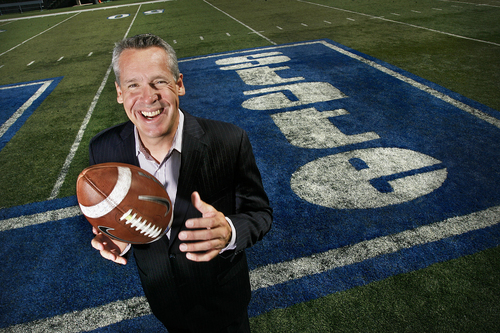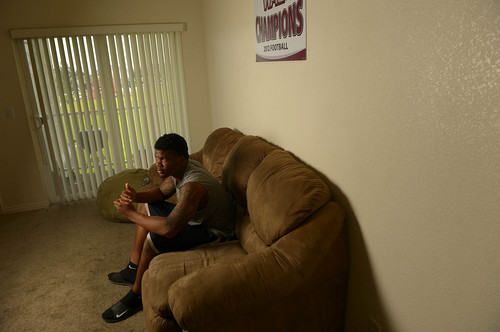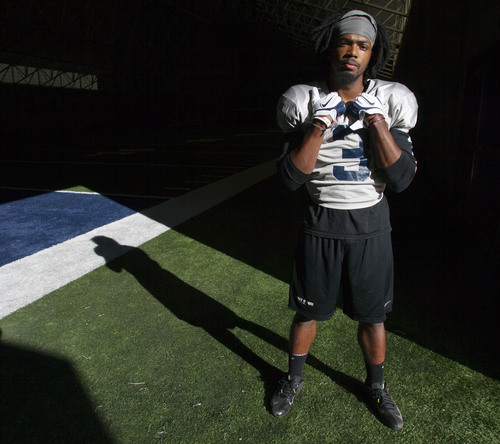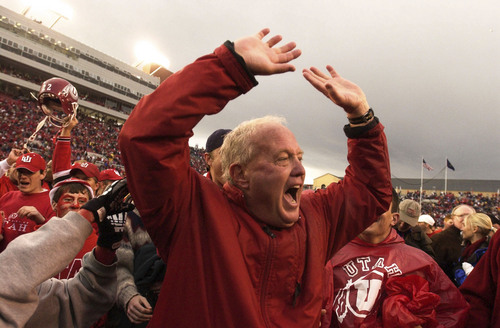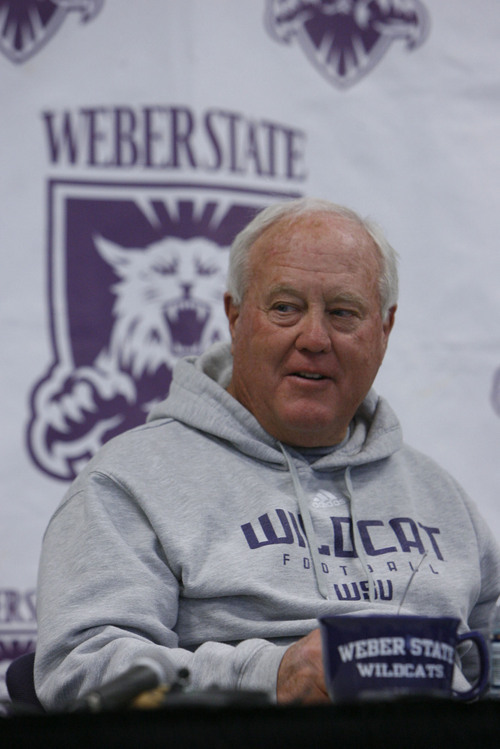This is an archived article that was published on sltrib.com in 2014, and information in the article may be outdated. It is provided only for personal research purposes and may not be reprinted.
His sister, living in Miami, needs bus money to get to school. His brother, playing football at his second junior college in two years, can't always pay his bills alone. His mother toils at an Atlanta Wal-Mart to support his four younger siblings.
While he was suiting up for Utah State University's football team, it wasn't enough for linebacker Tavaris McMillian to perform. He had to provide.
An injury has ended his playing career, but McMillian will continue to receive a monthly stipend and send about $150 to $200 to family until he finishes his degree and the checks dry up in December.
Then, he'll need to find a new job.
—
Paid to play • Days after a landmark antitrust ruling paved the way for greater compensation for NCAA athletes, more challenges loom. Potential outcomes range from fattened stipend checks to a free market that resembles pro leagues.
Even as the NCAA argues that paying players lofty sums would compromise a core ideal — do-it-for-the-love-of-the-game amateurism — the stories of local players suggest that has long been fantasy.
Many scholarship players, such as McMillian, rely on the $700 to $1,100 they get each month for room and board — a fixed amount that doesn't reflect how many hours they work or how much money they generate for others.
In McMillian's case, two of his half-brothers were killed, and he couldn't afford to fly back to attend their funerals. In May, with no check, he barely scraped by. Then, this summer, any hopes that he might someday make millions playing football were dashed by a nagging shoulder problem.
A casual observer might envy McMillian the team-issued Nike threads he sports around Logan, but he doesn't have much else. Former teammate and roommate Quinton Byrd often bought his groceries.
"[People] don't see the inside; they see the outside," says McMillian, who, like Byrd, is an interdisciplinary studies major and a Miami native. "Everybody thinks we're well taken care of."
The median revenue generated by Football Bowl Subdivision schools doubled from 2004 ($28 million) to 2012 ($56 million), and former University of Utah running back (1992-93) and Atlanta Falcons Pro Bowler Jamal Anderson says he's amazed how much the business has mushroomed since his playing days.
"You look at the salary and the bonuses of everybody involved in intercollegiate athletic sports — it's a great job," Anderson says. "It's a great living. And the only thing that hasn't changed … the student-athlete situation is the same."
Which is to say, student-athletes get an opportunity for which many are grateful — but many are struggling to pay rent and feed themselves while the wealth expands for their schools, their conferences and the NCAA.
—
Paper chase • In the face of lawsuits and mounting criticism, officials counter that athletes are given the chance to obtain a degree that pays off over the course of their lifetimes.
Federal Judge Claudia Wilken ordered this month in O'Bannon v. NCAA that schools be allowed to provide athletes with "full cost of attendance" stipends and up to $5,000 each year for the use of their likenesses.
The NCAA has announced its intent to appeal, but it recently granted more autonomy to five power conferences angling for incremental changes such as padded stipends and longer-term medical care.
Change, of some sort, is on the way.
Utah athletic director Chris Hill says he welcomes autonomy and wants to do more for his student-athletes. Still, he doesn't see the current model as a raw deal.
"It's very hard to be in my position and talk about this, because it's the big, bad company office against somebody else," acknowledges the onetime captain of Rutgers men's basketball team. "But [it's] really kind of sad in that people don't really understand the amount of money that's gone into their own education."
The NCAA estimates that of 20,042 freshman football players in 2013, just 254 will be drafted by an NFL team. All of them think they can make a living playing football, Hill says, "but, I'll tell you, a lot of them come here and realize, 'Oh, I'm the third-team running back and I'm not going to make it, so man, this is a pretty good deal.'"
What's more, the stipend checks for off-campus room and board could theoretically earn a married Utah student-athlete as much as $13,236 per year (see box). Then there is the travel. The gear. The facilities. The coaching. The medical care.
All told, higher-education researchers Delta Cost Project figured that the average FBS school was spending $92,000 per year on each student-athlete, compared with $14,000 per nonathlete.
It's not nothing.
But it often doesn't pay the bills.
—
Family matters • Recently graduated Utah defensive tackle Tenny Palepoi is the 13th of 14 children.
His wife, Delaney, took a job with a candle warmer manufacturer after the couple moved from Snow College to Salt Lake City. She soon had to quit, though: Tenny would be out until 8 p.m. each night — lifting, practicing, watching film and studying — and their two young children needed to be cared for.
The little left over from Tenny's stipend check after rent went to diapers, and the Utah football captain required WIC assistance and food stamps to cover the rest. Dinner and a movie were rare treats for the couple.
Palepoi, now in training camp with the NFL's San Diego Chargers, says he benefited from the lesson in budgeting and prioritizing. However, "the majority of kids who do get stipends, most of their money goes to bills," he says. "They're left with about $100, $200 to budget with, which is not nearly enough."
You soon learn tricks to the trade, Byrd says. You don't shop. You pile as many clothes as possible into the coin-op washers. You decline the team meal plan and use that money instead to buy and cook bulk portions of meat, which you eat for days.
Big purchases such as furniture can be tricky, requiring players to comb discounts or giveaways. Some Utah State players once tried to rent furniture, but couldn't make payments. Now they go without couches.
"It's like having a dead-end job, where you live check to check," says Byrd, currently angling for a spot on an NFL camp roster.
And he was one of the relatively lucky ones. Uncles, aunts and cousins occasionally would send Byrd money to buy a few extras, while he paid it forward in food for the less-fortunate McMillian.
McMillian's story is hardly unique. Byrd estimates at least 10 teammates couldn't call their families for help if their checks ran out.
BYU basketball guard Kyle Collinsworth says his parents help him with rent and other expenses, yet it's still tough for him to afford healthy food.
"I don't think I could live off that $900 a month without help from home," he says. "… That $900 goes pretty fast, especially if you are trying to pay rent, gas for your car, all that kind of stuff."
Unlike nonathletes, football players aren't able to work during the season. That leaves summer jobs — washing cars, landscaping, making youth camp cameos, etc. — to pad their savings before they spend an average 43.3 hours a week on sports and 38 hours a week on academics, according to a 2011 NCAA survey. Men's basketball players devoted an average of 39 hours a week to their teams.
"The only thing I'm asking for is a little more money so we can live," sophomore Utah offensive lineman Isaac Asiata said during spring camp. "I'm not asking for it so I can go live in a huge house on the hill and play college football. I'm just asking so that I can pay for my two-bedroom apartment."
Asiata says he, like McMillian, tries to send money home to his family when possible. Former Utah and Tennessee Titans safety Robert Johnson said this spring that he used to do the same.
"That's not uncommon," says Utah head coach Kyle Whittingham. But "that's not that much money when you talk about what they need to sustain themselves. There's not that much left over."
—
Checks and balances • Several Utes have noticed that with the cost of living rising, the checks don't go as far as they used to, Utah defensive lineman Daniel Nielson said this spring.
"Everybody knows, with the inflation now, it's not enough," he said. "I do know that there are people out there fighting for us and they'll do the right thing. It just takes time."
Stipends — or simply "checks," in the parlance — are so vital that talk of them even pervades recruiting pitches.
Former Utah and Weber State head coach Ron McBride says it's an age-old problem for coaches in low cost-of-living locales that they have to explain to recruits that they do not actually get "paid better" elsewhere.
"A lot of times," he says, "coaches would [tell recruits], 'My scholarship is worth X amount of money and [their] scholarship is worth this amount of money.' "
The conversation continues after they arrive on campus, too.
In Los Angeles for Pac-12 Media Days last month, Whittingham used some downtime to chat with Utes Dres Anderson and Nate Orchard about NCAA revisions to meal rules. The players could have less money taken from their monthly checks, or they could put those funds back into the meal plan and enjoy a greater selection.
Whittingham told them to take the options back to the team to see which they would prefer. Then he left them with a request: Some of the younger guys on the team might be a little too focused on checks and food. Help keep their eyes on the prize, all right?
Yes, coach.
Anderson and Orchard are on Utah's leadership council, a function of many Division I teams in which players meet regularly with coaches to address food, stipends and other lifestyle concerns.
The coaches do their best to accommodate them.
Byrd says Utah State players asked to be removed from a then-mandatory meal plan in favor of having more money in their checks, and coaches complied. Head coach Matt Wells also has out-of-state players over to his house for dinner as much as the NCAA allows, and that counts for a lot, Byrd says.
But coaches' compassion is limited by NCAA rules. When McMillian's half brother Davonte Anderson was shot and killed in December, the USU linebacker hoped the school could lend him financial aid so he could fly home and pay his respects. Although Wells went to bat for him, the NCAA denied the request because Anderson was a half-brother and not a full sibling.
McMillian mourned one of his closest childhood friends from 2,500 miles away.
"It's rough because I knew Coach Wells wanted to help me, and the school wanted to help me," he says. "[Wells and I] shed tears together."
—
Should they want more? • If college football players sound quite a bit like employees, well, that's the conclusion reached by the National Labor Relations Board earlier this year.
Cases such as a Northwestern player's bid for the right to unionize and Wilken's ruling in O'Bannon v. NCAA have pressured officials to make pre-emptive changes —like granting autonomy to large conferences — but there's a line they won't cross.
Pac-12 Commissioner Larry Scott, at the front lines of the charge for autonomy, remains adamant that players should not be treated as professionals. A stipend check that covers full cost of attendance is reasonable, he says. A check that reflects the millions athletes generate is not.
It bears noting, then, that Scott received $3.3 million for the 2012 calendar year. In 2012-13, the Pac-12 generated $334 million in revenue, according to its tax returns.
"My compensation is set by our presidents," reasons Scott. "… They make the decision every year whether that was a good decision for them or not a good decision and what my compensation should be."
In other words, Scott can be canned. It's a nebulous distinction. College athletes are let go if they decide to stop playing sports. They're let go if they don't follow team rules. Arguably — though Scott disputes it — they are let go if they do not perform.
What do players think, then? Are they employees? Is their stipend check a price-fixed paycheck?
"Pretty much, because you go to school every day, then after school you go straight to practice," Byrd says. "It's one set rate. You don't get what you put in. If I spend extra time watching film, or [lifting] weight, I don't get overtime."
Hill acknowledges it does strike him as unfair that, for many athletes, the sole path to the professional ranks is through the NCAA. But if the NCAA or conferences get in the business of paying athletes, he's not sure schools will want to associate with them anymore.
Maybe there should be a semi-pro option, he says.
Wilken's ruling suggests there already is, and that, legally speaking, it's the NCAA.
Says Jamal Anderson: "It's convenient to call it 'collegiate athletics,' so you don't have to pay the labor."
Tribune reporter Jay Drew contributed to this story.
kgoon@sltrib com Twitter: @kylegoon mpiper@sltrib.co Twitter: @matthew_piper
What players receive
Checks vary due to cost of living, but at the University of Utah, athletes on full scholarships will receive 10 checks for $924.60 per month for the 2014-15 school year — up $3 from 2013-14. They can earn two more checks if they are enrolled during summer semester. Those who are married will get $1,103 per month. Many — like Utah's football players — will see less if their teams opt to funnel that money back into meal options.
Education value
At the University of Utah, the full cost of attendance for an out-of-state student is $25,208 per year. For an in-state student, it's $7,876. However, as economist Andy Schwarz noted in an editorial on Deadspin.com, this is a list price. The actual cost to the U. of providing a scholarship to a student-athlete may be far lower.
Challenges to current model
At the end of March, a regional director of the National Labor Relations Board ruled that football players at Northwestern University had the right to unionize because in all traditional respects, they were engaged in an employee/employer relationship with the private school. More recently, the NCAA and video game maker Electronic Arts settled with a class of current and former players for tens of millions, and a group of ex-players, headlined by former UCLA basketball star Ed O'Bannon, won an injunctive order in U.S. District Court that will, pending appeal, allow players to profit off their likenesses (see story below). The same judge will also hear one or more cases arguing that the NCAA has unlawfully capped compensation for athletes at the value of an athletic scholarship. The outcome of those cases could create a free market for college athletes.




